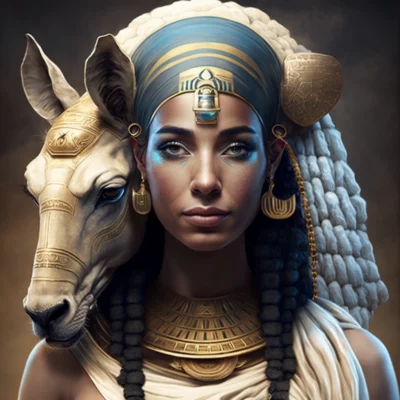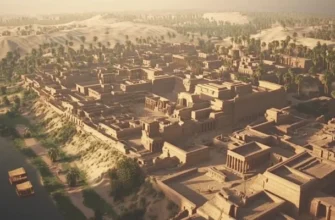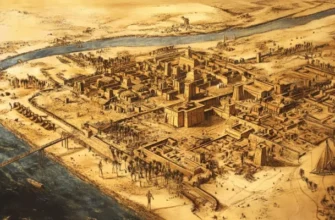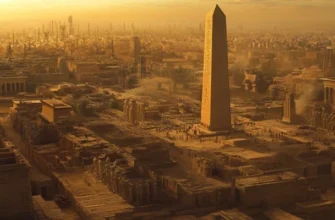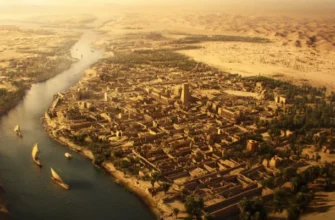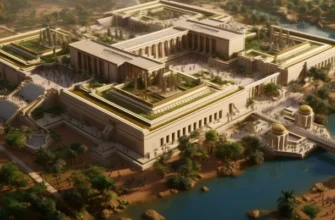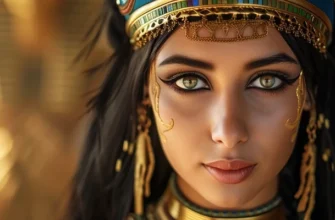The Egyptian goddess Amunet is one of the most revered goddesses in ancient Egyptian mythology. Her name comes from the word “amon”, which means “hidden” or “invisible”. Amunet was depicted as a woman with a lion’s head or as a lioness with a woman’s face.
Amunet was depicted as a woman with a griffin’s head or a cap of feathers. Her symbols were the ostrich feather and palm tree, as well as a sword and shield, indicating her military strength. She was also associated with sin and justice, as reflected in her depiction with scales and blindfolded eyes.
Amunet was the patroness of arts and crafts, and she was revered as the goddess of writing and books. She was also associated with light and singing, and was often depicted with a lyre.
During the New Kingdom period, when the god Amun became one of the most important gods in Egypt, Amunet took on a new meaning, becoming his wife and the mother of the gods. She also became a symbol of a divine mother who helped women in childbirth.
In general, Amunet was a very respected goddess in ancient Egyptian religion. Her images can be seen in many temples and shrines, and her name has remained in history as a symbol of female wisdom and strength.
Among all the other goddesses of Egyptian mythology, Amunet was also quite important in magic. She was often mentioned as a protector of those who turned away from the old deities and as a goddess who could calm and soften the anger of an angry deity.
Egyptian shrines dedicated to Amunet were usually built near the temples of Amun, and they were often shared with them. These shrines had their own special ritual, which included burning aromatic substances and offering food and drink to the goddess.
Thus, Amunet is one of the important goddesses of ancient Egypt who symbolized wisdom, power, magic, arts and crafts.
Amunet in mythology and religion
In ancient Egyptian mythology, Amunet was the patroness of love and motherhood. She was also revered as a goddess of war and protection. The representations of Amunet changed over time, and she was often associated with other goddesses such as Ishtar or Sekhmet.
Amunet is one of the important goddesses of ancient Egypt, who occupied an important place in the mythology and religion of the Egyptian people. She was a symbol of wisdom, power, magic, and art, and her cult was widespread throughout Egypt. In this article, we will take a closer look at her role in Egyptian mythology and religion.
In Egyptian mythology, Amunet was often mentioned as the daughter of the god Ra, who was the main god of the sun and sky. According to one myth, she was born as a result of Ra allocating a part of his soul and spirit to create a new goddess who became a symbol of his wisdom and power.
Amunet is also known as the goddess of fertility and motherhood. She was often depicted with clay figures that symbolized children and was revered as the patroness of mothers and newborns. Many local shrines dedicated to Amunet were places of worship for those who sought protection and help from the maternal wisdom and strength of the goddess.
Amunet was also considered the patroness of arts and crafts. She was a symbol of crafts that were associated with textiles, sewing and jewelry, as well as art and architecture. Many local artisans and artists dedicated their creations to Amunet, hoping for her blessing and protection.
In the religion of Egypt, Amunet was associated with the cult of Amun, who was the main god of the city of Thebes. During the New Kingdom, when Amun became one of the most popular gods in Egypt, the cult of Amunet also became very important. She was considered the wife of Amun and the mother of Mut, the goddess of heaven and earth. At the center of the cult of Amun were the temples at Luxor and Karnak, which became some of the largest and most impressive structures of the ancient world.
In the temples of Amun and Amonet, religious rites dedicated to the gods were held. These rites included donations, prayers, and religious dances, and various ceremonies were held in honor of the gods. For example, in the temples of Amun and Amonet, festivals were held to celebrate the beginning and end of the crop rotation, as well as festivals dedicated to the goddess of fertility.
Images of Amunet in Egyptian religion were of great importance. She was depicted as a woman with the head of a sheep, with sensual lips and large eyes. She was often depicted wearing many pieces of jewelry, such as earrings, bracelets, and rings, symbolizing her power over magic and natural forces.
All those who honor and worship Amunet believe that she can protect them from evil and come to their aid in difficult situations. She was also a symbol of the patronage of women and children, and still remains one of the most famous and revered goddesses of ancient Egypt.
Symbolism of Amunet
Amunet was depicted with numerous symbols that reflected her various aspects. The most common symbols were the lion, the white crown, and the sun. Amunet also often appeared with a feather tassel or a celestial crown on her head.
The symbolism of the Egyptian goddess Amunet contained many meanings, which were reflected in her appearance and religious rites. The image of Amunet often contained the symbolism of a sheep, which was one of the main animals associated with the god Amun.
The head of a sheep
One of the main symbols of Amunet was the head of a sheep. Its image could be different, but it always contained a special energy and femininity. The sheep’s head also symbolized gentleness and sensitivity, which were considered important traits of the goddess. In addition, the sheep was associated with fertility, which was also reflected in the image of Amunet with a sheep’s head.
All the jewelry that was on the image of the sheep’s head also had its own meaning. For example, large earrings could symbolize Amonet’s power over natural forces, and bracelets and rings could symbolize her ability to control magic and spiritual forces.
A wand with fern leaves
Another important symbol of Amunet is the rod of fern leaves. This rod symbolized life and fertility, and the fern leaves reflected the moisture that was necessary for plant growth and fertility of the land. It is also believed that this rod may represent the magic that the goddess had over nature and life.
Jewelry and clothing
Amunet also had a lot of jewelry and wore different clothes. She was usually depicted wearing a long dress that symbolized her power and status as a goddess. Many pieces of jewelry, such as earrings, bracelets, and necklaces, also had their own meaning. They could symbolize different things such as power, magic, charm, fertility, and life. For example, a necklace made of different kinds of grains reflected the fertility and wealth of the land, and a necklace made of different kinds of gemstones could symbolize the wealth and power of Amonet.
Crown and birds
Amunet’s crown was also an important symbol. It looked like a tall crown with feathers, which symbolized the birds associated with the god Amun. These birds, in particular the stork and the dove, were considered holy animals and symbolized life and heavenly wisdom. Amunet’s crown also reflected her power and status as a goddess.
Much of the symbolism associated with Amunet was related to nature and fertility. Depictions of Amunet with various animals, plants, and different types of gemstones could represent different aspects of nature and its interaction with humans. This symbolism reflected the important place that the goddess Amunet held in Egyptian mythology and religion and her important role in the life of the Egyptian people.
Representations of Amunet in art
Depictions of Amunet were common in various art forms, including statues and reliefs. The most famous image is the statue of Amunet in the Temple of Amun in Luxor. In addition, Amunet symbolism was used in interior design and jewelry.
The representation of the goddess Amunet in the art of ancient Egypt was widespread and reflected her important place in the religion and culture of this ancient civilization. She was depicted in a variety of forms and poses, including statues, reliefs, images on household objects, and works of art.
Statues
Statues of the goddess Amunet usually depicted her in a status pose with her tall crown of feathers symbolizing her power. Her face was depicted with delicate features and deeply set eyes, giving her expressive wisdom and strength. The goddess Amunet was often depicted with a baby pharaoh on her breast, indicating her role as a mother and patroness.
Reliefs
Reliefs of the goddess Amunet usually depicted her in front of natural elements such as rivers, mountains, and trees, reflecting her important role in nature. On some reliefs, Amunet was depicted with other deities such as Amun and Ra as a symbol of the unification of different gods and their powers.
Household items
The goddess Amunet was also depicted on various household items, such as vases, dishes, amulets, and others. On such objects, her image was usually combined with other symbols, such as lotuses, sunflowers, and various animals, which gave them additional meaning and power.
All of these forms of representation of Amunet in art reflect her important role in the religion and culture of ancient Egypt, where the goddess was considered a symbol of motherhood, fertility, wisdom, and power. The images of the goddess on household items and art were not only a decorative element, but also had religious and magical meanings that were supposed to help people in certain life situations.
For example, amulets with the image of the goddess Amunet were usually worn to protect against evil and illness, as well as to ensure happy motherhood and fertility. Depictions of the goddess on vases and other household items indicated her role in rituals related to birth, life, and death, and served as a symbol of hope for the goddess’s help and support in human life.
All of these representations of Amunet in art testify to her importance in the religion and culture of Egypt and how this goddess influenced the lives of people at the time. Many pieces of art depicting Amunet have survived to this day, helping modern scholars to better understand the role of the goddess in ancient Egyptian civilization.
The importance of Amunet in the modern world
Amunet remains a popular topic in the culture of the modern world. She appears in various movies, TV shows, and literature. Amunet has also been the subject of research in various fields such as archaeology, art history, and religious studies. Amunet’s research allows for a better understanding of the culture and religion of ancient Egypt, as well as contributes to the development of science and knowledge of human history.
The Egyptian goddess Amunet is of great importance not only in the history and culture of Ancient Egypt, but also in the modern world. The image of the goddess Amunet is still popular in art, amulets, and other objects of religious and cultural significance. Her story and symbolism continue to inspire people to explore the ancient culture of Egypt.
In the modern world, the image of the goddess Amunet can be found in various forms of art. She is a source of inspiration for artists, designers, and fashion designers who create exquisite patterns and jewelry featuring her image. In addition, the image of Amunet helps to create an atmosphere and add a magical component to interiors in different styles.
Also, the image of the goddess Amunet is still popular among seekers of spirituality. In the modern world, Amunet is considered one of the main goddesses that symbolizes femininity, wisdom, and power. Her image is used for meditation, to create amulets that are worn for protection and to ensure fertility.
In general, the significance of Amunet in the modern world is that its symbolism and history inspire people to explore Egyptian culture, create various artistic works, and find their spirituality. In addition, Amunet plays an important role in gender and feminist issues. Her depiction as a deity who gives birth and nourishes life is considered an important symbol of female power and wisdom. Her symbolism is often used to emphasize the importance of feminine energy and wisdom in our world.
In general, the significance of the goddess Amunet in the modern world is that she inspires people to reflect on the ancient culture of Egypt, to create art, to develop spirituality, and to reflect on female power and wisdom. The image of Amunet is still one of the most popular symbols that has remained relevant for centuries and continues to inspire people around the world.
Conclusion.
The Egyptian goddess Amunet occupies an important place in ancient Egyptian mythology and religion. Her symbolism and representation reflect many aspects of the culture and daily life of the population of ancient Egypt. Studies of Amunet help to better understand the history and culture of the ancient world, as well as enrich our knowledge of human history and religious beliefs.
